Application of Machine Learning to Tree Species Classification Using Active and Passive Remote Sensing: A Case Study of the Duraer Forestry Zone
Abstract
1. Introduction
2. Materials and Methods
2.1. Study Area
2.2. Data
2.2.1. Field Survey Data
2.2.2. Drone Multispectral Data
2.2.3. UAV Lidar Data
2.2.4. Satellite Data
2.3. Methods
2.3.1. Extraction of Spectral Features and Texture Features
2.3.2. Extraction of Vertical Features
2.3.3. Classification Technique
2.3.4. Confusion Matrix
2.3.5. GEE Workflow
- (1)
- Data query and display based on the study area boundary, where the study area vector boundary (feature collection: ao) is imported and the retrieved data are cropped based on the boundary.
- (2)
- Extraction of the best classification elements, which include the best spectral bands, vegetation indices, and texture features (glcm), as well as the CHM derived from the DEM and DSM.
- (3)
- Importation of training sample data based on feature combination, for which the extracted elements are combined and imported into the region of interest (ROI).
- (4)
- Comparison of classification methods and accuracy check, for which the classification accuracy of three classifiers in the ROI are combined to obtain the confusion matrix. Finally, the classification results, accuracy, and kappa of each classifier are calculated, as are the PA and UA of individual tree species.
3. Results
3.1. Comparison of Tree Species Classification Schemes
3.2. Comparison of Tree Species Classification Methods
3.3. Spatial Distribution of the Tree Species Classification Based on RF
3.4. Spatial Distribution of the Tree Species Classification Based on GEE
4. Discussion
5. Conclusions
- (1)
- When the classification features were selected, we found that the addition of the CHM to the combination of spectral and textural features for classification improved the overall classification results, indicating that the CHM is an important indicator for improving the classification accuracy of tree species and is important in distinguishing forest from nonforest and white birch from larch.
- (2)
- Comparing the accuracy of machine learning methods under the conditions of choosing equal classification elements, we observed the clear advantage of the random forest among a group of machine learning methods when classifying tree species. This also indicated that RF was the best tree classification method applicable to the data source and the selected scheme of this paper and to the Duraer Forestry Zone.
- (3)
- Our study showed that combining the spectral features, textural features, and vertical features of multisource data (UAV multispectral, LiDAR data, and auxiliary data) and using RF could effectively improve the forest species classification accuracy in the three sample strips within the Duraer Forestry Zone in Arxan.
- (4)
- When applied to a large area following the above research process, the use of the GEE program combined with the required satellite data can support accurate, complex, and rapid tree species classification. The classification results are not limited to specific environments or in cases with data-limited conditions.
Author Contributions
Funding
Institutional Review Board Statement
Informed Consent Statement
Data Availability Statement
Acknowledgments
Conflicts of Interest
References
- Dixon, R.K.K.; Solomon, A.; Brown, S.; Houghton, R.; Trexier, M.; Wisniewski, J. Carbon Pools and Flux of Global Forest Ecosystems. Science 1994, 263, 185–190. [Google Scholar] [CrossRef] [PubMed]
- Hansen, M.C.; Potapov, P.V.; Moore, R.M.; Hancher, M.; Turubanova, S.; Tyukavina, A.; Thau, D.; Stehman, S.; Goetz, S.; Loveland, T.R.; et al. High-Resolution Global Maps of 21st-Century Forest Cover Change. Science 2013, 342, 850–853. [Google Scholar] [CrossRef] [PubMed]
- Zhao, J.; Xie, H.; Ma, J.; Wang, K. Integrated remote sensing and model approach for impact assessment of future climate change on the carbon budget of global forest ecosystems. Glob. Planet. Change 2021, 203, 103542. [Google Scholar] [CrossRef]
- Grabska, E.; Hostert, P.; Pflugmacher, D.; Ostapowicz, K. Forest Stand Species Mapping Using the Sentinel-2 Time Series. Remote Sens. 2019, 11, 1197. [Google Scholar] [CrossRef]
- Bouvier, M.; Durrieu, S.; Fournier, R.; Renaud, J. Generalizing predictive models of forest inventory attributes using an area-based approach with airborne LiDAR data. Remote Sens. Environ. 2015, 156, 322–334. [Google Scholar] [CrossRef]
- Barrett, F.; McRoberts, R.E.; Tomppo, E.; Cienciala, E.; Waser, L.T. A questionnaire-based review of the operational use of remotely sensed data by national forest inventories. Remote Sens. Environ. 2016, 174, 279–289. [Google Scholar] [CrossRef]
- Franklin, S.E.; Peddle, D.R. Classification of SPOT HRV imagery and texture features. Int. J. Remote Sens. 1990, 11, 551–556. [Google Scholar] [CrossRef]
- Soh, L.-K.; Tsatsoulis, C. Texture analysis of SAR sea ice imagery using gray level co-occurrence matrices. IEEE Trans. Geosci. Remote Sens. 1999, 37, 780–795. [Google Scholar] [CrossRef]
- Zou, X.; Li, D. Application of image texture analysis to improve land cover classification. WSEAS Trans. Comput. Arch. 2009, 8, 449–458. [Google Scholar]
- Xie, Y.; Sha, Z.; Yu, M. Remote sensing imagery in vegetation mapping: A review. J. Plant Ecol. 2008, 1, 9–23. [Google Scholar] [CrossRef]
- Brovkina, O.V.; Cienciala, E.; Surový, P.; Janata, P. Unmanned aerial vehicles (UAV) for assessment of qualitative classification of Norway spruce in temperate forest stands. Geo-Spat. Inf. Sci. 2018, 21, 12–20. [Google Scholar] [CrossRef]
- Deur, M.; Ga\vsparović, M.; Balenovic, I. Tree Species Classification in Mixed Deciduous Forests Using Very High Spatial Resolution Satellite Imagery and Machine Learning Methods. Remote Sens. 2020, 12, 3926. [Google Scholar] [CrossRef]
- Chen, W.; Xie, X.; Wang, J.; Pradhan, B.; Hong, H.; Bui, D.; Duan, Z.; Ma, J. A comparative study of logistic model tree, random forest, and classification and regression tree models for spatial prediction of landslide susceptibility. Catena 2017, 151, 147–160. [Google Scholar] [CrossRef]
- Hssina, B.; Merbouha, A.; Ezzikouri, H.; Erritali, M. A comparative study of decision tree ID3 and C4.5. Int. J. Adv. Comput. Sci. Appl. 2014, 4, 13–19. [Google Scholar] [CrossRef]
- Loh, W.-Y. Classification and regression trees. WIREs Data Min. Knowl. Discov. 2011, 1, 14–23. [Google Scholar] [CrossRef]
- Song, Y.; Lu, Y. Decision tree methods: Applications for classification and prediction. Shanghai Arch. Psychiatry 2015, 27, 130–135. [Google Scholar]
- Vapnik, V.N. The Nature of Statistical Learning Theory; Springer Science & Business Media: Berlin/Heidelberg, Germany, 2000. [Google Scholar]
- Wallraven, C.; Caputo, B.; Graf, A.B.A. Recognition with local features: The kernel recipe. In Proceedings of the Ninth IEEE International Conference on Computer Vision, Nice, France, 13–16 October 2003. [Google Scholar] [CrossRef]
- Pontil, M.; Verri, A. Support Vector Machines for 3D Object Recognition. IEEE Trans. Pattern Anal. Mach. Intell. 1998, 20, 637–646. [Google Scholar] [CrossRef]
- Schüldt, C.; Laptev, I.; Caputo, B. Recognizing human actions: A local SVM approach. In Proceedings of the International Conference on Pattern Recognition, Cambridge, UK, 23–26 August 2004; Volume 3, pp. 32–36. [Google Scholar]
- Breiman, L. Random forests. Mach. Learn. 2001, 45, 5–32. [Google Scholar] [CrossRef]
- Sonobe, R.; Tani, H.; Wang, X.; Kobayashi, N.; Shimamura, H. Random forest classification of crop type using multi-temporal TerraSAR-X dual-polarimetric data. Sens. Lett. 2014, 5, 157–164. [Google Scholar] [CrossRef]
- Dobrinic, D.; Gašparović, M.; Medak, D. Sentinel-1 and 2 Time-Series for Vegetation Mapping Using Random Forest Classification: A Case Study of Northern Croatia. Remote Sens. 2021, 13, 2321. [Google Scholar] [CrossRef]
- Ke, Y.; Quackenbush, L.J.; Im, J. Synergistic use of QuickBird multispectral imagery and LIDAR data for object-based forest species classification. Remote Sens. Environ. 2010, 114, 1141–1154. [Google Scholar] [CrossRef]
- Tassi, A.; Vizzari, M. Object-Oriented LULC Classification in Google Earth Engine Combining SNIC, GLCM, and Machine Learning Algorithms. Remote Sens. 2020, 12, 3776. [Google Scholar] [CrossRef]
- Lechner, M.; Dostálová, A.; Hollaus, M.; Atzberger, C.; Immitzer, M. Combination of Sentinel-1 and Sentinel-2 Data for Tree Species Classification in a Central European Biosphere Reserve. Remote Sens. 2022, 14, 2687. [Google Scholar] [CrossRef]
- Praticò, S.; Solano, F.; Di Fazio, S.; Modica, G. Machine Learning Classification of Mediterranean Forest Habitats in Google Earth Engine Based on Seasonal Sentinel-2 Time-Series and Input Image Composition Optimisation. Remote Sens. 2021, 13, 586. [Google Scholar] [CrossRef]
- Gorelick, N.; Hancher, M.; Dixon, M.; Ilyushchenko, S.; Thau, D.; Moore, R. Google Earth Engine: Planetary-scale geospatial analysis for everyone. Remote Sens. Environ. 2017, 202, 18–27. [Google Scholar] [CrossRef]
- Holmgren, J.; Persson, Å.; Söderman, U. Species identification of individual trees by combining high resolution LiDAR data with multi—Spectral images. Int. J. Remote Sens. 2008, 29, 1537–1552. [Google Scholar] [CrossRef]
- Eisavi, V.; Homayouni, S.; Yazdi, A.M.; Alimohammadi, A. Land cover mapping based on random forest classification of multitemporal spectral and thermal images. Environ. Monit. Assess. 2015, 187, 291. [Google Scholar] [CrossRef]
- Dalponte, M.; Bruzzone, L.; Gianelle, D. Tree species classification in the Southern Alps based on the fusion of very high geometrical resolution multispectral/hyperspectral images and LiDAR data. Remote Sens. Environ. 2012, 123, 258–270. [Google Scholar] [CrossRef]
- Heinzel, J.C.; Koch, B. Investigating multiple data sources for tree species classification in temperate forest and use for single tree delineation. Int. J. Appl. Earth Obs. Geoinf. 2012, 18, 101–110. [Google Scholar] [CrossRef]
- Bannari, A.; Morin, D.; Bonn, F.J.; Huete, A.R. A review of vegetation indices. Remote Sens. Rev. 1995, 13, 95–120. [Google Scholar] [CrossRef]
- Trier, Ø.D.; Salberg, A.-B.; Kermit, M.; Rudjord, Ø.; Gobakken, T.; Næsset, E.; Aarsten, D. Tree species classification in Norway from airborne hyperspectral and airborne laser scanning data. Eur. J. Remote Sens. 2018, 51, 336–351. [Google Scholar] [CrossRef]
- Baugh, W.; Groeneveld, D. Broadband vegetation index performance evaluated for a low—Cover environment. Int. J. Remote Sens. 2006, 27, 4715–4730. [Google Scholar] [CrossRef]
- Motohka, T.; Nasahara, K.N.; Oguma, H.; Tsuchida, S. Applicability of Green-Red Vegetation Index for Remote Sensing of Vegetation Phenology. Remote Sens. 2010, 2, 2369–2387. [Google Scholar] [CrossRef]
- Louhaichi, M.; Borman, M.M.; Johnson, D.E. Spatially Located Platform and Aerial Photography for Documentation of Grazing Impacts on Wheat. Geocarto Int. 2001, 16, 65–70. [Google Scholar] [CrossRef]
- Wang, Y.; Lu, D. Mapping Torreya grandis Spatial Distribution Using High Spatial Resolution Satellite Imagery with the Expert Rules-Based Approach. Remote Sens. 2017, 9, 564. [Google Scholar] [CrossRef]
- Xie, Z.; Chen, Y.; Lu, D.; Li, G.; Chen, E. Classification of Land Cover, Forest, and Tree Species Classes with ZiYuan-3 Multispectral and Stereo Data. Remote Sens. 2019, 11, 164. [Google Scholar] [CrossRef]
- Crippen, R. Calculating the vegetation index faster. Remote Sens. Environ. 1990, 34, 71–73. [Google Scholar] [CrossRef]
- Hernandez, I.E.R.; Shi, W. A Random Forests classification method for urban land-use mapping integrating spatial metrics and texture analysis. Int. J. Remote Sens. 2018, 39, 1175–1198. [Google Scholar] [CrossRef]
- DigitalGlobe. The Benefits of the Eight Spectral Bands of Worldview-2; DigitalGlobe: Westminster, CO, USA, 2011. [Google Scholar]
- Feng, Y.; Lu, D.; Chen, Q.; Keller, M.; Moran, E.; dos-Santos, M.; Bolfe, É.L.; Batistella, M. Examining effective use of data sources and modeling algorithms for improving biomass estimation in a moist tropical forest of the Brazilian Amazon. Int. J. Digit. Earth 2017, 10, 996–1016. [Google Scholar] [CrossRef]
- Lewis-Beck, M.; Bryman, A.; Futing Liao, T. CART (Classification and Regression Trees); Sage Publications, Inc.: Thousand Oaks, CA, USA, 2004. [Google Scholar]
- Dalponte, M.; Bruzzone, L.; Vescovo, L.; Gianelle, D. The role of spectral resolution and classifier complexity in the analysis of hyperspectral images of forest areas. Remote Sens. Environ. 2009, 113, 2345–2355. [Google Scholar] [CrossRef]
- Camps-Valls, G.; Bruzzone, L. Kernel-based methods for hyperspectral image classification. IEEE Trans. Geosci. Remote Sens. 2005, 43, 1351–1362. [Google Scholar] [CrossRef]
- Immitzer, M.; Atzberger, C.; Koukal, T. Tree Species Classification with Random Forest Using Very High Spatial Resolution 8-Band WorldView-2 Satellite Data. Remote Sens. 2012, 4, 2661–2693. [Google Scholar] [CrossRef]
- Niu, Z.G.; Shan, Y.X.; Gong, P. Accuracy evaluation of two global land cover data sets over wetlands of China. Int. Arch. Photogramm. Remote Sens. Spat. Inf. Sci. 2012, XXXIX-B7, 223–228. [Google Scholar] [CrossRef]
- Yang, Y.; Yang, D.; Wang, X.; Zhang, Z.; Nawaz, Z. Testing Accuracy of Land Cover Classification Algorithms in the Qilian Mountains Based on GEE Cloud Platform. Remote Sens. 2021, 13, 5064. [Google Scholar] [CrossRef]
- Rodriguez-Galiano, V.F.; Ghimire, B.; Rogan, J.; Chica-Olmo, M.; Rigol-Sánchez, J.P. An assessment of the effectiveness of a random forest classifier for land-cover classification. ISPRS J. Photogramm. Remote Sens. 2012, 67, 93–104. [Google Scholar] [CrossRef]
- Guyot, G.; Guyon, D.; Riom, J. Factors affecting the spectral response of forest canopies: A review. Geocarto Int. 1989, 4, 3–18. [Google Scholar] [CrossRef]
- Lapini, A.; Pettinato, S.; Santi, E.; Paloscia, S.; Fontanelli, G.; Garzelli, A. Comparison of Machine Learning Methods Applied to SAR Images for Forest Classification in Mediterranean Areas. Remote Sens. 2020, 12, 369. [Google Scholar] [CrossRef]
- Bortolot, Z.J.; Wynne, R. Estimating forest biomass using small footprint LiDAR data: An individual tree-based approach that incorporates training data. ISPRS J. Photogramm. Remote Sens. 2005, 59, 342–360. [Google Scholar] [CrossRef]
- Frazer, G.; Magnussen, S.; Wulder, M.; Niemann, K.O. Simulated impact of sample plot size and co-registration error on the accuracy and uncertainty of LiDAR-derived estimates of forest stand biomass. Remote Sens. Environ. 2011, 115, 636–649. [Google Scholar] [CrossRef]
- Ussyshkin, V.; Theriault, L. Airborne Lidar: Advances in Discrete Return Technology for 3D Vegetation Mapping. Remote Sens. 2011, 3, 416–434. [Google Scholar] [CrossRef]
- Li, M.; Im, J.; Quackenbush, L.J.; Liu, T. Forest Biomass and Carbon Stock Quantification Using Airborne LiDAR Data: A Case Study Over Huntington Wildlife Forest in the Adirondack Park. IEEE J. Sel. Top. Appl. Earth Obs. Remote Sens. 2014, 7, 3143–3156. [Google Scholar] [CrossRef]
- Lu, D.; Weng, Q. A survey of image classification methods and techniques for improving classification performance. Int. J. Remote Sens. 2007, 28, 823–870. [Google Scholar] [CrossRef]
- Fassnacht, F.E.; Latifi, H.; Stereńczak, K.; Modzelewska, A.; Lefsky, M.A.; Waser, L.T.; Straub, C.; Ghosh, A. Review of studies on tree species classification from remotely sensed data. Remote Sens. Environ. 2016, 186, 64–87. [Google Scholar] [CrossRef]
- Puttonen, E.; Suomalainen, J.M.; Hakala, T.; Räikkönen, E.; Kaartinen, H.; Kaasalainen, S.; Litkey, P. Tree species classification from fused active hyperspectral reflectance and LIDAR measurements. For. Ecol. Manag. 2010, 260, 1843–1852. [Google Scholar] [CrossRef]
- Tian, S.; Zhang, X.; Tian, J.; Sun, Q. Random Forest Classification of Wetland Landcovers from Multi-Sensor Data in the Arid Region of Xinjiang, China. Remote Sens. 2016, 81, 954. [Google Scholar] [CrossRef]
- Phan, T.N.; Kuch, V.; Lehnert, L.W. Land Cover Classification using Google Earth Engine and Random Forest Classifier—The Role of Image Composition. Remote Sens. 2020, 12, 2411. [Google Scholar] [CrossRef]
- Tamiminia, H.; Salehi, B.; Mahdianpari, M.; Quackenbush, L.; Adeli, S.; Brisco, B. Google Earth Engine for geo-big data applications: A meta-analysis and systematic review. ISPRS J. Photogramm. Remote Sens. 2020, 164, 152–170. [Google Scholar] [CrossRef]
- Lindenmayer, D.; Margules, C.; Botkin, D. Indicators of Biodiversity for Ecologically Sustainable Forest Management. Conserv. Biol. 2000, 14, 941–950. [Google Scholar] [CrossRef]
- McCammon, A.L.T. United Nations Conference on Environment and Development, held in Rio de Janeiro, Brazil, during 3–14 June 1992, and the ’92 Global Forum, Rio de Janeiro, Brazil, 1–14 June 1992. Environ. Conserv. 1992, 19, 372–373. [Google Scholar] [CrossRef]
- Salazar, A.; Safont, G.; Vergara, L.; Vidal, E. Pattern recognition techniques for provenance classification of archaeological ceramics using ultrasounds. Pattern Recognit. Lett. 2020, 135, 441–450. [Google Scholar] [CrossRef]
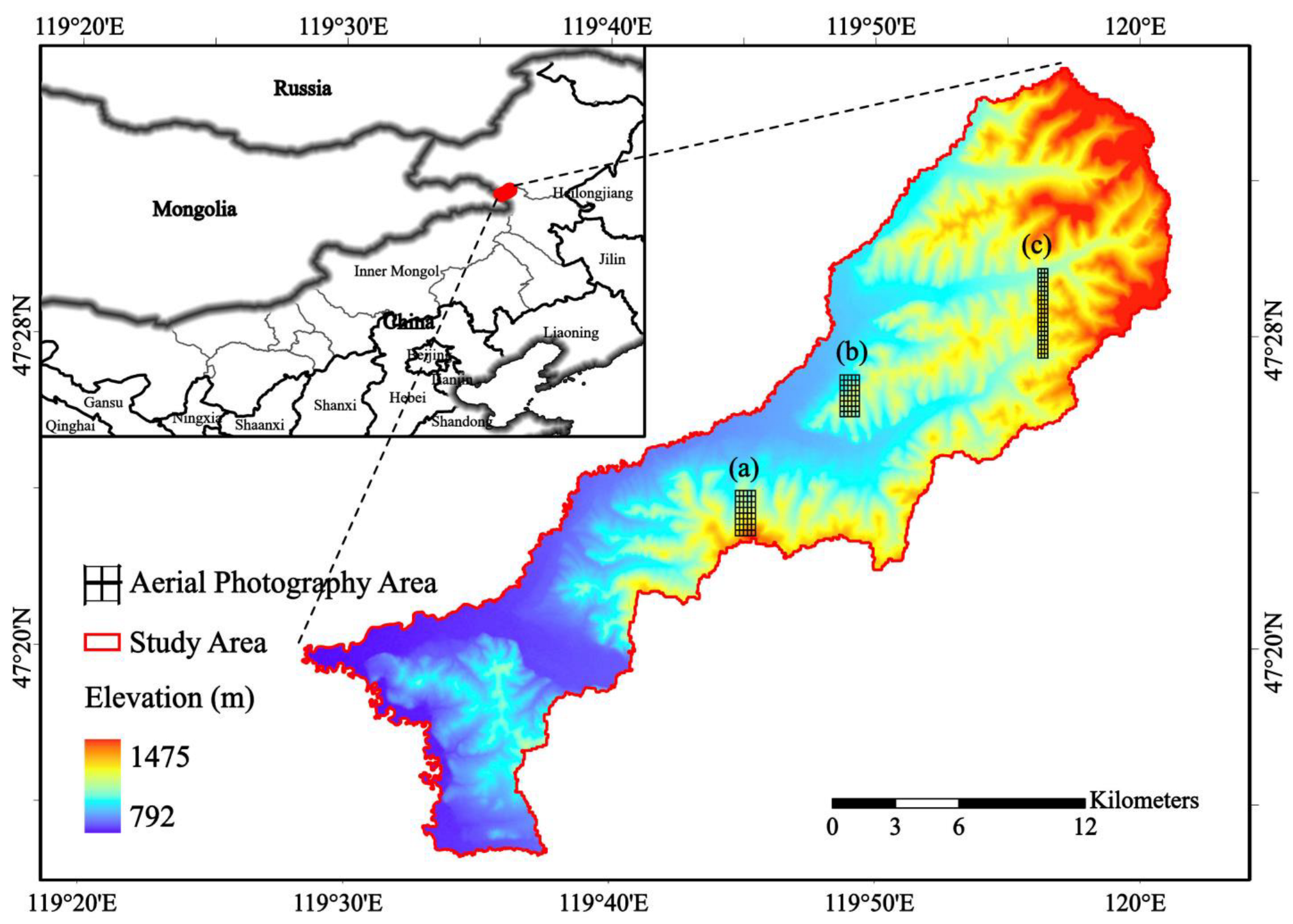
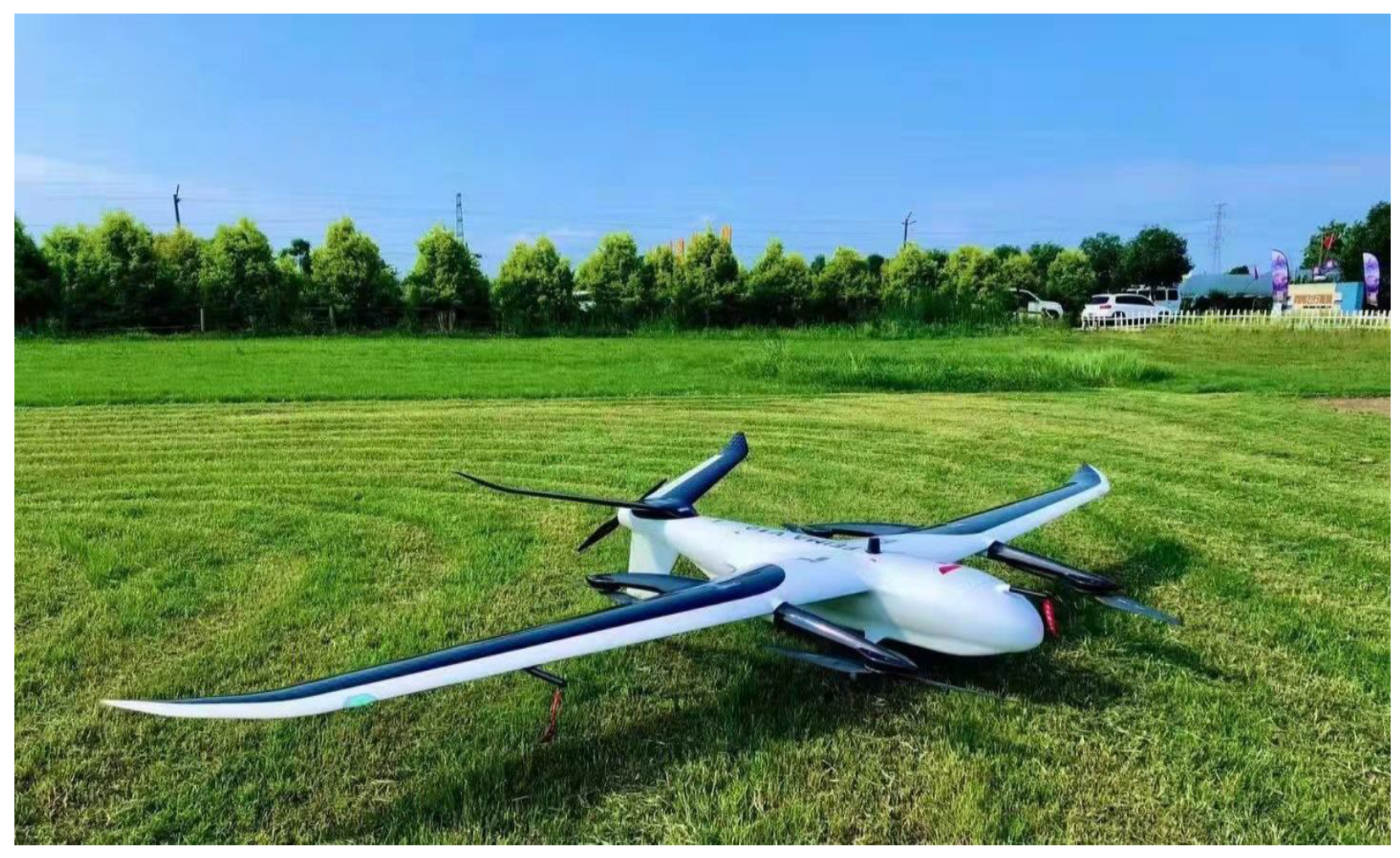
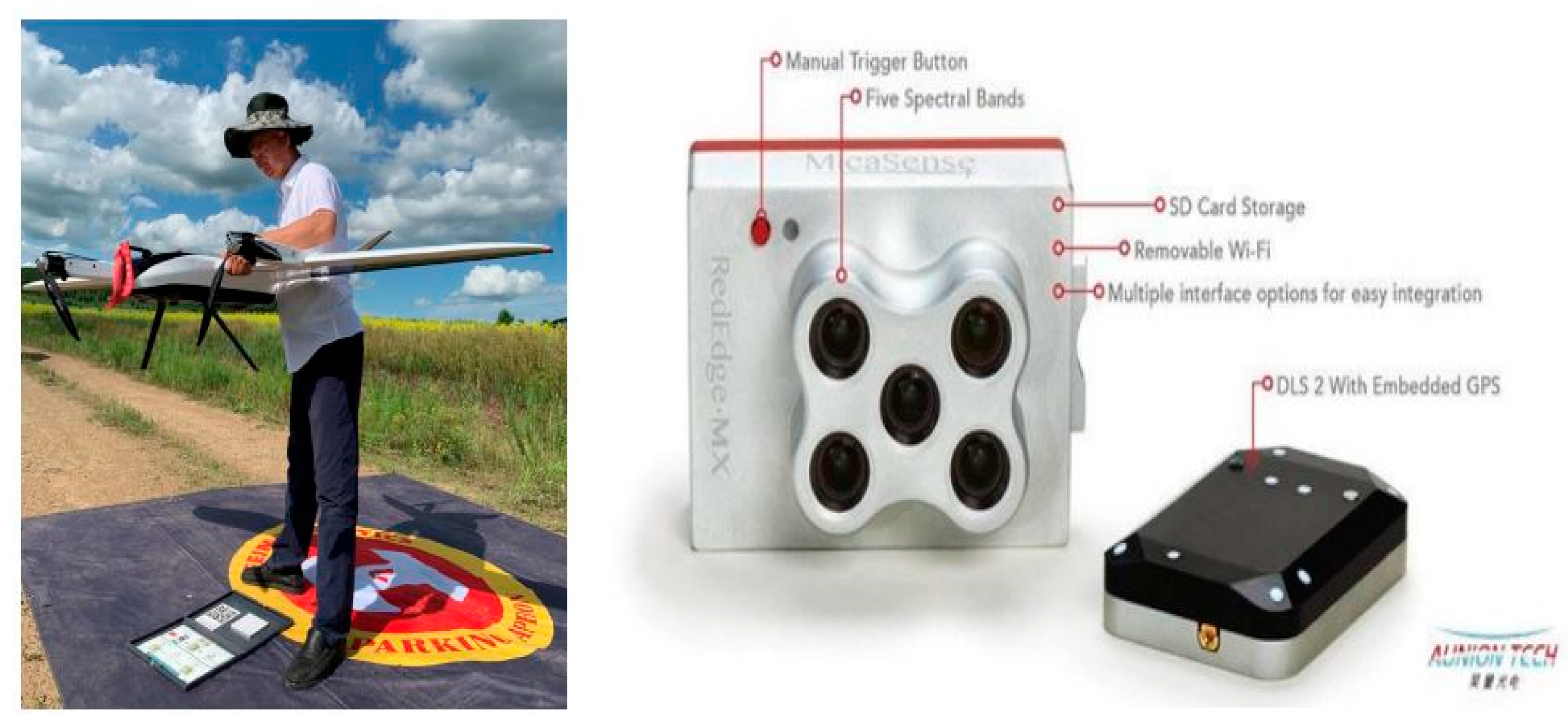
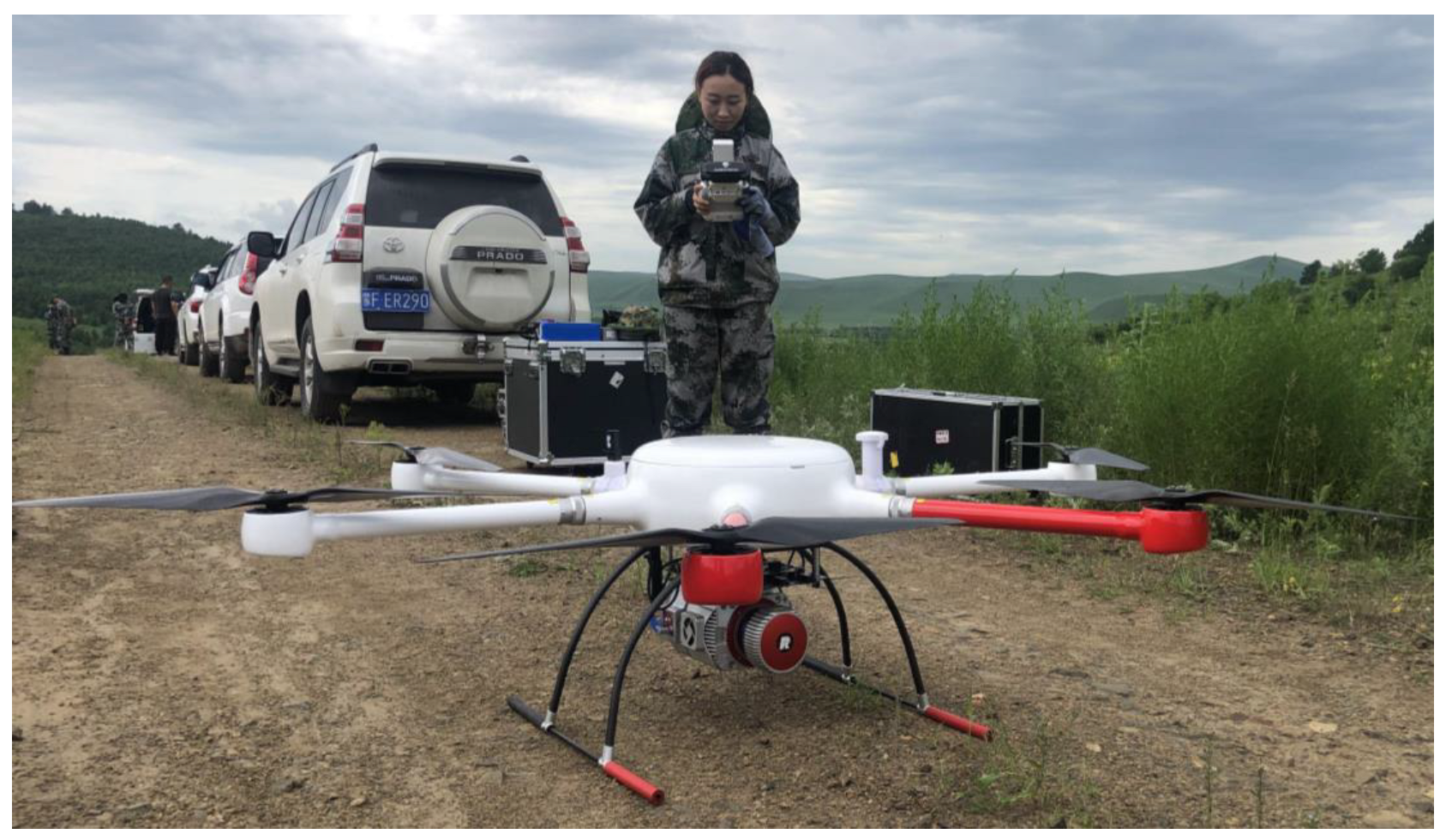
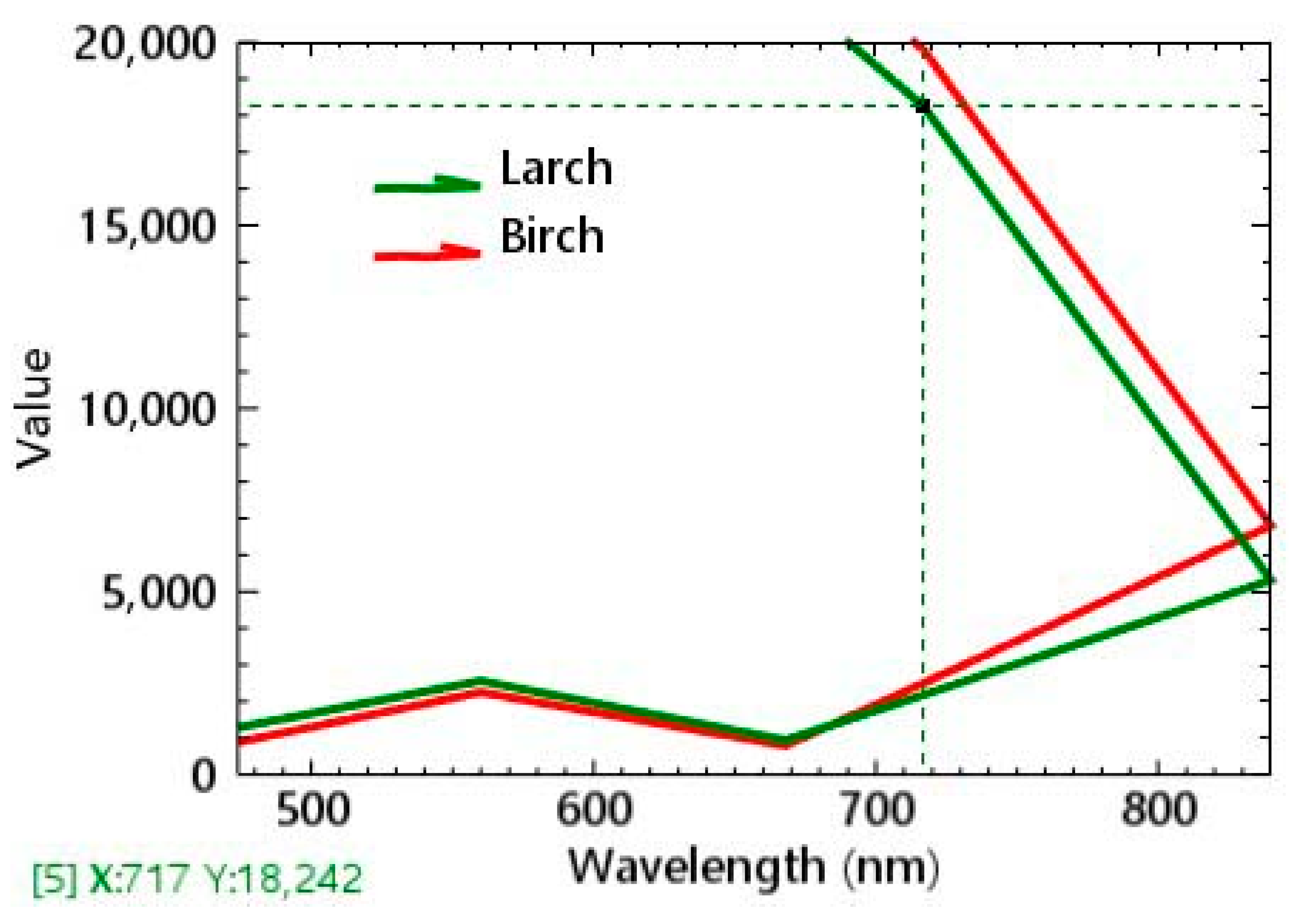
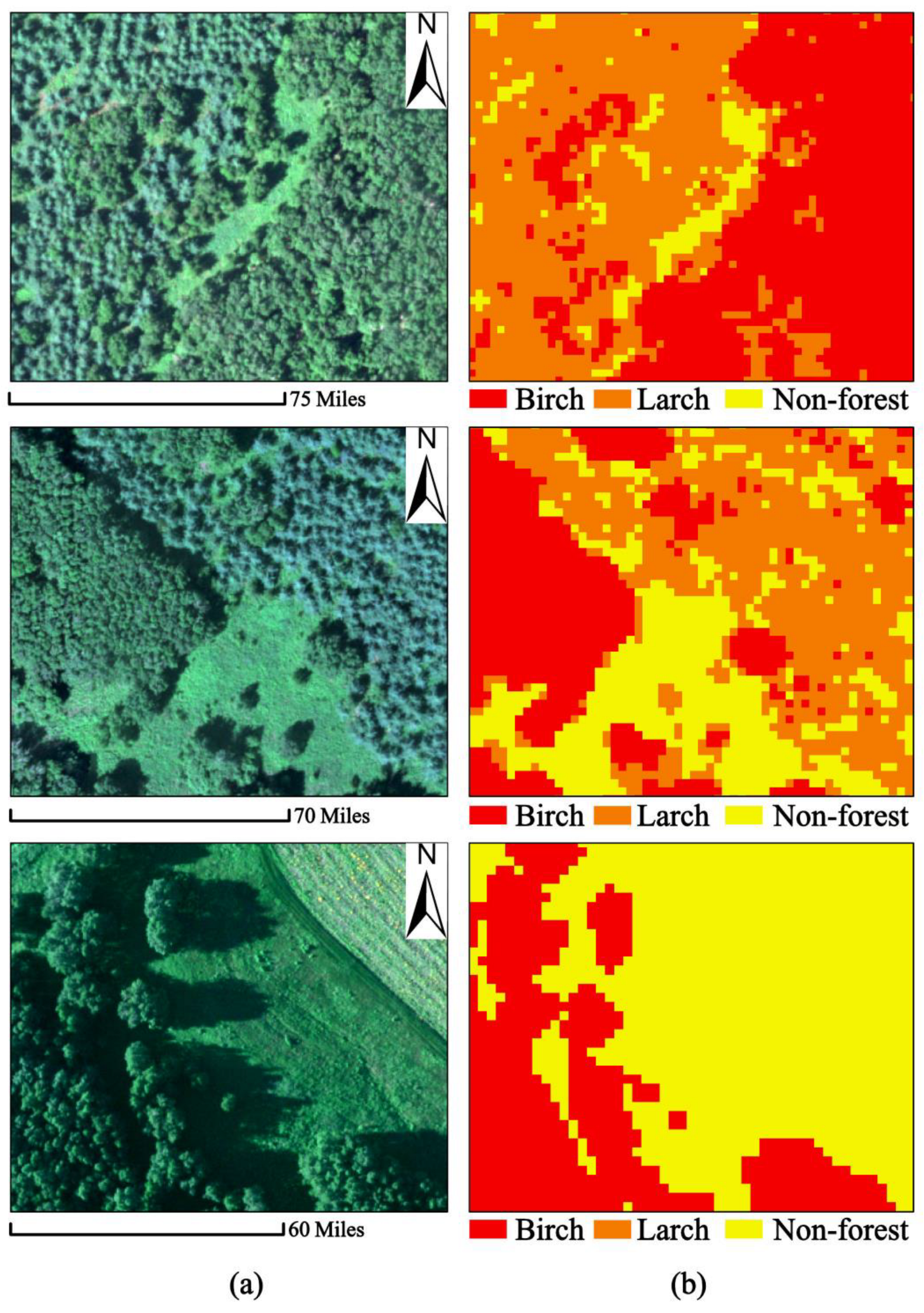
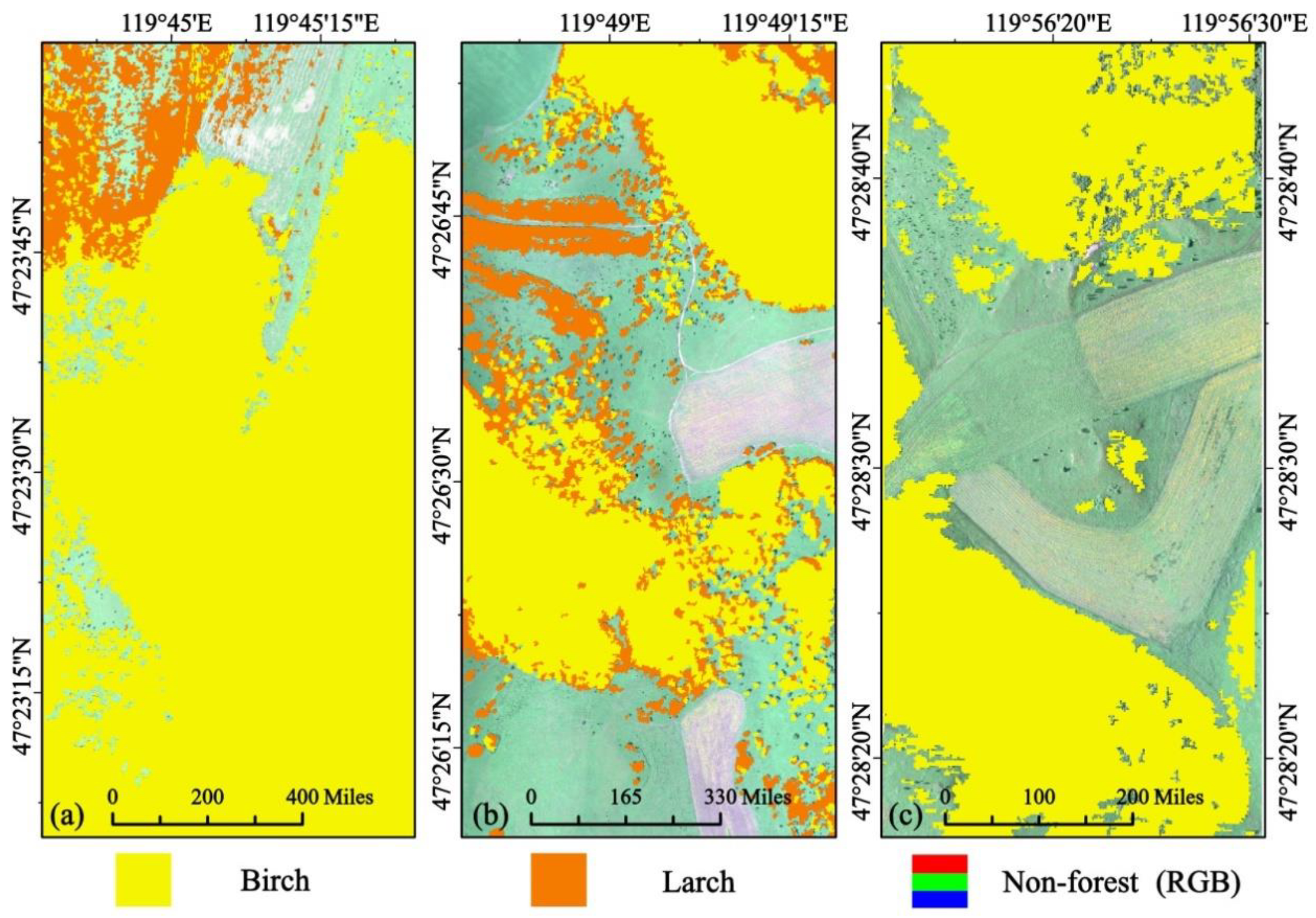

| Band | Band Name | Wavelength | Wave Width |
|---|---|---|---|
| Band 1 | Blue (B) | 475 | 20 |
| Band 2 | Green (G) | 560 | 20 |
| Band 3 | Red (R) | 668 | 10 |
| Band 4 | Near-infrared (NIR) | 840 | 40 |
| Band 5 | Red edge (RE) | 717 | 10 |
| Core Parameters ARS-1000 L | |
|---|---|
| Maximum flight height | 1350 m |
| Range resolution | ±5 cm |
| Scanning angle | ±330° |
| Angle resolution | 0.001° |
| Pulse frequency | 820 KHZ |
| Laser wavelength | Near-infrared |
| Beam divergence | 0.5mrad |
| Band Number | Band Name | Band Length (nm) | Bandwidth (nm) | Resolution (m) |
|---|---|---|---|---|
| 1 | Coastal Aerosol | 443.9 | 27 | 60 |
| 2 | Blue | 496.6 | 98 | 10 |
| 3 | Green | 560.0 | 45 | 10 |
| 4 | Red | 664.5 | 38 | 10 |
| 5 | Vegetation red edge (RE) | 703.9 | 19 | 20 |
| 6 | Vegetation red edge (RE) | 740.2 | 18 | 20 |
| 7 | Vegetation red edge (RE) | 782.5 | 28 | 20 |
| 8 | Near-infrared (NIR) | 835.1 | 145 | 10 |
| 8a | Vegetation red edge (RE) | 864.8 | 33 | 20 |
| 9 | Water Vapour | 945.0 | 26 | 60 |
| 10 | SWIR_Cirrus | 1373.5 | 75 | 60 |
| 11 | SWIR | 1613.7 | 143 | 20 |
| 12 | SWIR | 2202.4 | 242 | 20 |
| Features | Abbreviation | Formula | Reference |
|---|---|---|---|
| Normalized Difference Vegetation Index | NDVI | [34] | |
| Ratio Vegetation Index | RVI | [33] | |
| Enhanced Vegetation Index | EVI | [35] | |
| Difference Vegetation Index | DVI | [38] | |
| Green-Red Vegetation Index | GRVI | [36] | |
| Infrared Percentage Vegetation Index | IPVI | [40] | |
| Near infrared and Blue Band Ratios | - | [38] | |
| Renormalized Difference Vegetation Index | RDVI | [43] | |
| Visible-band Difference Vegetation Index | VDVI | [37] | |
| Optimized Soil Adjusted Vegetation Index | OSAVI | [39] | |
| Grayscale Symbiosis Matrix | GLCM | Mean Variance Contrast Homogeneity Dissimilarity Correlation Angular Second Moment Entropy | |
| Edge Enhancement | - | Median Sobel Roberts User-defined | |
| Statistical Filter | - | Data range Mean Variance Entropy Skewness |
| Birch | Larch | Nonforest | ||
|---|---|---|---|---|
| Scheme Ⅰ | PA | 80% | 48% | 85% |
| UA | 87% | 51% | 76% | |
| OA: 79% | Kappa: 0.63 | |||
| Scheme Ⅱ | PA | 90% | 70% | 84% |
| UA | 91% | 83% | 87% | |
| OA: 86% | Kappa: 0.75 | |||
| RF | SVM | CART | ||
|---|---|---|---|---|
| Birch | PA | 90% | 93% | 95% |
| UA | 91% | 77% | 75% | |
| Larch | PA | 70% | 52% | 44% |
| UA | 63% | 65% | 62% | |
| Nonforest | PA | 84% | 72% | 70% |
| UA | 87% | 93% | 90% | |
| OA | 86% | 81% | 78% | |
| kappa | 0.75 | 0.67 | 0.63 | |
| Swamp Willow (ROI) | Poplar (ROI) | Spruce (ROI) | Sphagnum Pine (ROI) | Birch (ROI) | Larch (ROI) | Nonforest (ROI) | Total | |
|---|---|---|---|---|---|---|---|---|
| Swamp Willow | 2125 | 2 | 6 | 2 | 0 | 16 | 4 | 2155 |
| Poplar | 1 | 2259 | 0 | 1 | 9 | 23 | 1 | 2294 |
| Spruce | 7 | 0 | 2004 | 6 | 0 | 2 | 14 | 2033 |
| Sphagnum pine | 12 | 4 | 12 | 8742 | 16 | 70 | 7 | 8863 |
| Birch | 28 | 33 | 7 | 21 | 31,750 | 100 | 58 | 31,997 |
| Larch | 37 | 30 | 29 | 41 | 24 | 11,866 | 38 | 12,065 |
| Nonforest | 19 | 0 | 10 | 26 | 25 | 26 | 16,561 | 16,667 |
| Total | 2229 | 2328 | 2068 | 8839 | 31,824 | 12,103 | 16,683 | 76,074 |
Disclaimer/Publisher’s Note: The statements, opinions and data contained in all publications are solely those of the individual author(s) and contributor(s) and not of MDPI and/or the editor(s). MDPI and/or the editor(s) disclaim responsibility for any injury to people or property resulting from any ideas, methods, instructions or products referred to in the content. |
© 2023 by the authors. Licensee MDPI, Basel, Switzerland. This article is an open access article distributed under the terms and conditions of the Creative Commons Attribution (CC BY) license (https://creativecommons.org/licenses/by/4.0/).
Share and Cite
Rina, S.; Ying, H.; Shan, Y.; Du, W.; Liu, Y.; Li, R.; Deng, D. Application of Machine Learning to Tree Species Classification Using Active and Passive Remote Sensing: A Case Study of the Duraer Forestry Zone. Remote Sens. 2023, 15, 2596. https://doi.org/10.3390/rs15102596
Rina S, Ying H, Shan Y, Du W, Liu Y, Li R, Deng D. Application of Machine Learning to Tree Species Classification Using Active and Passive Remote Sensing: A Case Study of the Duraer Forestry Zone. Remote Sensing. 2023; 15(10):2596. https://doi.org/10.3390/rs15102596
Chicago/Turabian StyleRina, Su, Hong Ying, Yu Shan, Wala Du, Yang Liu, Rong Li, and Dingzhu Deng. 2023. "Application of Machine Learning to Tree Species Classification Using Active and Passive Remote Sensing: A Case Study of the Duraer Forestry Zone" Remote Sensing 15, no. 10: 2596. https://doi.org/10.3390/rs15102596
APA StyleRina, S., Ying, H., Shan, Y., Du, W., Liu, Y., Li, R., & Deng, D. (2023). Application of Machine Learning to Tree Species Classification Using Active and Passive Remote Sensing: A Case Study of the Duraer Forestry Zone. Remote Sensing, 15(10), 2596. https://doi.org/10.3390/rs15102596






